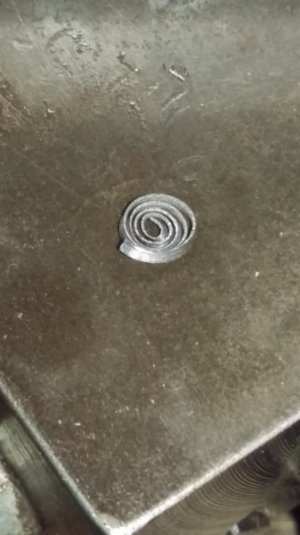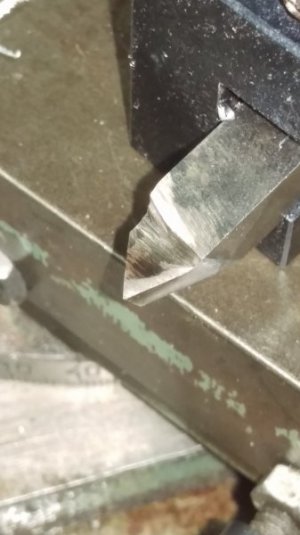I guess I'm not
Sorry Mikey but I am just answering in rebuttal to what seems as anti carbide/misinformation on threads I read ...
...and I also agree and like to see the grinding (sharpening) skill of cutters going onward;
...Sharpening carbide also does just that (Again; I'm not talking about insert tooling in the home, hobby setting (But grabbing a handful from a bucket of dull or chipped throw aways can also be silver soldered to prehard or boring bars and sharpened...(and IMO; My take (experience) with carbide is also good for the beginner/novice and home machinist to know and consider...
...Again and granted; A diamond wheel (I prefer a 220 "face wheel") is the way to sharpen carbide (with a coarser (around 100) diamond wheel on a regular old 8" "snag grinder is the way to rough form one (if needed)...
...But then, with all the same info around here (for instance like you have also posted) on HSS cutter angles and experimentation as applied to different materials, one ends up with a superior cutter (many times longer lasting edge) for most materials (steels,...especially the tool steels) on any lathe (that isn't "slop city" lol)...
....Again; Some carbides aren't much better(**) for wear than HSS and some it behooves one to put a little more nose radius (chipping) for heavy and interupted cuts...
....(**)= again depending on grades (thangs' such as cobalt content, grain size, tonnage of press, hot (or not lol) isostatically pressed...and yada yada
...so with all that, I'll post this link again and notice the braised carbide cutter pics and illustrations (ground forms and angles) are very much the same as HSS:
https://www.google.com/search?q=car...X&ved=0ahUKEwjyqf3oydTQAhWhxVQKHZIDAyIQsAQIGg
Chris, my intent was to help a new guy learn to grind a good tool, that's all. As near as I can tell, I provided no misinformation. Instead, I tried to provide information as simply and accurately as I could.
If you're somehow construing that this post is a debate that somehow warranted a "rebuttal" from you, tell me what I said that justified such a vigorous response from you. Maybe instead of pushing your own agenda here, why not start a new thread that states your position and then teach the guys how to do what you think they should do? I may not agree with your views but I'll be damned if I don't respect your right to have them. And as I said before, I will not come into your thread and disrespect you.
I am not a pro machinist like you. I am a lowly hobby guy with only 25 years messing with metal so I'm still learning every day. I am also a Professional in my own field, with over 35 years of experience. In my world, professional conduct is somewhat different.
Mikey, I in no way think of anybody here as lowly....also I am not pushing my own or any agenda (In this subject case: Carbide as compared to HSS cutters)...
...But to answer how/and what that I construed a rebuttal (Which IMO is not so vigorous (I'm just also trying to teach and yes, no matter what experience we have, we all learn if we're open to it)...anyway, it is from a snippet from your subject somewhere above: "Most of us don't own big, rigid, fast or powerful lathes. We own hobby lathes, typically in the 10-11" class with max speeds of 2500 rpm or so. For those lathes and smaller, HSS is usually the best tooling option......"
...I guess so as not go round and round with examples and facts on your take again that carbide needs big, rigid, fast and powerful lathes that run more than 2500 RPM I will use your own words in previous threads: "We should agree to disagree"... (But note: I don't think I have ever ran a manual machine spindle at more than 2000 rpm except for high speed polishing and maybe for double o and triple 0 center drills, tiny drills and even then 1000 to 2000 depending on yada is norm)
...and again; My garage Logan, or the Machinists "old" 9" to 12" lathe area in our shop (Lablonde, Logan, Southbend and a pretty weak newer Clausing), although well kept, were anything but big, rigid, fast and powerful...
...I also think, in regards to your dis on my professionalism above, I thinks' (Hey" I heard that!), maybe (probably) it's a difference in perception plus what environment each of us has worked in for decades, as in my world one cannot help but develop layers of thick skin on the shop floor...
...also please note that every comment I have given you respect by way of saying: "with all due respect but I disagree"...and, like on your subject title here: " Great posts and step by step Mikey except...." And note that my disagreements (just carbide details and applications so far) are just that and usually include a "smiley face here"
...also I'm the 1st one to admit while using "production value" as the buzz words I've seen here on this site regarding authoring my own subject titles;
I would/am in last place as my only equipment in that regard is my "specs" and this laptop I'm pecking on now (again, even my phone is a $39.95 flip phone LOL)...
...so I'll just leave all the great "threads", questions, with pictures and videos to others and my silence usually means I'm learning or agree but when I see or read a detail that is off kilter I will respond with my opinion (and yes when the "off kilter" is somewhat repetitive, my response may include a "BS" (but followed with a "Smiley face here!")
...Maybe I need to work on my professionalism and friendliness and just read (unless I see or read something dangerous).... I'm sure all will get along fine without my input)
https://www.linkedin.com/in/christian-poulsen-49b05b30?trk=nav_responsive_tab_profile

